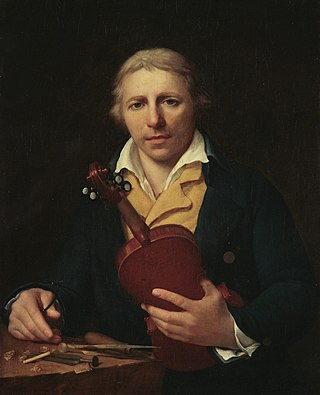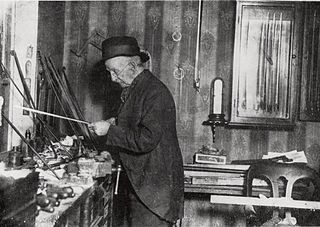Related Research Articles
Luigi Tarisio was an Italian violin dealer and collector.
Sesto Rocchi (1909–1991) was a violin maker from Reggio Emilia, Italy.
Arthur Richard Bultitude MBE was an English musical instrument bow maker, who spent much of his life working as a craftsman for the firm of W.E. Hill & Sons. Bultitude was brought to and introduced to the Hill shop by William Napier at the age of 14. Bultitude developed a close relationship with William Charles Retford, one of the foremost Hill makers after James Tubbs. Bultitude worked for the Hill shop from 1922 until 1961, after which he set up his own shop where he continued to make bows based on the same model set up by Alfred Hill. However he slowly moved away and made individual Bows built to suit particular customers. His bows are typically decorated with a silver Tudor Rose. The bows made for W.E. Hill & Sons are marked with number 6 on the tip under the bow hair. Bultitude was elected as Master of the Art Workers' Guild.
W. E. Hill & Sons is a British firm based in London that specialises in violins and other string instruments, and bows. It was also known as William Ebsworth Hill & Sons or William E. Hill & Sons.
William Charles Retford (1875–1970) and William R. Retford (1899–1960) were English musical instrument bow-makers, working for the firm of W.E. Hill & Sons. Retford is recognized as developing the Hill bow, along with Alfred Hill.
Franz Albert Nürnberger II (1854–1931) is regarded as one of the greatest German bow makers.
John Dodd was a British bowmaker. He was considered to be the greatest English bowmaker before and until James Tubbs.
William D Watson was an English bow maker. The last pupil of William Retford, William Watson worked for the firm of W.E. Hill & Sons from 1945 to 1962. He continued to make exemplary bows after leaving the firm and built a reputation as an authority on the history of British bow making. His bows for Hill are stamped with the number 7. He lived in Falmouth, Cornwall.

Nicolas Lupot was one of the most illustrious French luthiers of his time.

James Tubbs is one of the most celebrated English bow makers, and is considered "The English Tourte".
Joseph Arthur Vigneron was an important French Archetier / Bowmaker.
Jean Pierre Marie Persoit [Persois] - was a great and intriguing French bowmaker or Archetier.
Étienne Pajeot [Pageot], was an illustrious French archetier and bowmaker.
Jean Dominique Adam was an illustrious French Archetier / Bowmaker.
Frank Kovanda was an internationally known American maker of bows for stringed instruments.
Caressa & Français was a distinguished firm in Paris that specialized in fine musical instruments and bows.
Joseph Gaudé (1818–1881) was a French archetier, bowmaker and luthier.

Ashley is a village located in the southwest of Hampshire, England. It lies on the eastern outskirts of New Milton in the New Forest district, and is two miles (3 km) inland from the sea. Its history dates back to the Domesday book of 1086, when two estates were recorded. In the 15th century much of Ashley merged with a neighbouring manor, and the estate became known as Ashley Arnewood. As a village, Ashley began to develop in the 19th century when a church and a school were built. Most of the current village was built in the 20th century, and today Ashley is effectively a suburb of New Milton.
Charles François Gand (1787–1845) was one of the foremost violin makers/luthier and dealers of his time.
The Langonet Dynasty were a family of violin makers originating in Mirecourt, France, from around 1737 until the late 1900s.
References
- ↑ W.E. Hill & Sons (A Tribute)- Richard Sadler 1996 ISBN 0-9504357-2-4
- Leeson Bow, www.hillbows.com
- Bows and Bowmakers - W.C. Retford 1964 published by Strad
- W.E. Hill & Sons (A Tribute)- Richard Sadler 1996 ISBN 0-9504357-2-4
- Roda, Joseph (1959). Bows for Musical Instruments. Chicago: W. Lewis. OCLC 906667.
- Dictionnaire Universel del Luthiers - Rene Vannes 1951,1972, 1985 (vol.3)
- Universal Dictionary of Violin & Bow Makers - William Henley 1970